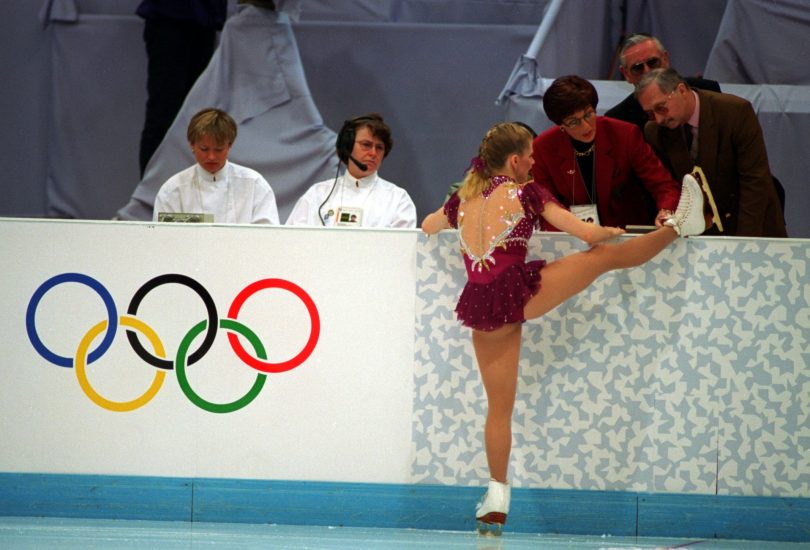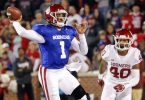Of the 16 Olympic Games I have written and reported from, two words stand out as the millstone of that experience:
Figure. Skating.
I don’t profess to know any more about ice and skates than you do, but I’ve seen a sequined Axel or two in my years. My Olympic resume’ runs the gamut from Dick Button’s bowtie to Johnny Weir’s feather boa.
Katarina Witt? I shared a pizza with her.
Nancy and Tonya? Yes, alas, I was there.
Lillehammer, Norway. Hamar Olympic Amphitheatre. Exactly 25 years ago today.
On Feb. 25, 1994, the ladies figure skating gold medal finals of the Lillehammer Winter Olympic Games drew the highest Friday night rating in the history of U.S. television. Nearly 44 percent of all the TVs owned in America – more than 105 million viewers — were watching the final chapter in the Tonya Harding-Nancy Kerrigan saga.
To put that into perspective, 98.2 million people watched this year’s Patriots-Rams Super Bowl.
If you saw the Hollywood rendition of the story, I, Tonya, you know most of the trainwreck details. In all, I thought it was a fun movie, though the film makers performed an unexplainable favor for the title character by casting the beautiful and accomplished Margot Robbie as the unapologetic Tonya.
In truth, there was nothing Hollywood about Tonya Harding. Skating is a sport that puts its athletes on display, quite literally, like no other. The vast, white sheet of ice forms an imposing stage around the solitary skater, who is being scrutinized from veritably the hair on her head to the tips of her skates. Judges even attend practice sessions and take notes.
Yet Harding has always tried to skate around the truth.
When she arrived in Lillehammer, the USOC mandated that she submit to a major press conference, where the very first question came from Jere Longman of the New York Times:
“Tonya, you lied to us about your smoking,” Jere said. “You lied to the FBI. You lied to investigators back in Oregon. You failed at least two polygraph exams.
“Why should we believe anything you say?”
And on that pleasant note, the week began.
The highlight/lowlight of the days before the final skate came during a practice session, the first in which Kerrigan and Harding were scheduled to be on the ice together.
Lillehammer organizers had not planned on having the world’s media cover an ice skating practice. The practice rink, therefore, had no seating area, only a small metal deck that protruded from the rafters.
My description, as it appeared in the Fort Worth newspaper:
Here I was, your humble Olympic correspondent and an estimated 499 of his soon-to-be very closest friends, shoehorned onto a make-shift ledge in the roof of a tiny ice rink.
There is a radio guy to my left, prattling loudly into a microphone in non-stop Norwegian. There is a 3-foot-long Nikon lens jammed into my rib cage. Two CBS guys, 20 feet apart, are talking to each other on cellular phones. A Japanese TV man just tried to crawl through my knees.
We couldn’t move, but we dared not leave. This was the story on this day, on nearly every day of these Olympic Games.
My newspaper column continued:
At 1:33 p.m., Harding arrives, and a hush descends upon the crowd. Camera shutters whir. Harding warms up with spins and twists and immediately returns to her coach, Diane Rawlinson.
Harding is coughing. She has asthma. She reached for a small spray canister and aims it down her throat.
“Looks like Primatene Mist,” someone in the media gallery announces.
And 500 note pads write down, “Primatene Mist.”
At 1:39 p.m., it is Harding’s turn to practice her long program, and Kerrigan is next.
“Next skater, Tonya Harding,” the rink announcer says. “Nancy Kerrigan, please prepare.”
A loud voice from my right says, “‘Did he say ‘prepare’ or ‘beware’?”
There are so many people on the ledge that only a handful can see everything. The rest of us rely on war bulletins from the front line.
“She just tried a triple axel,” a voice says.
And 500 note pads write down, “Triple axel.”
The instructions from my editor, as I recall, were to “write Nancy-and-Tonya” as much as possible.
Never mind the men’s skating competition. I can’t even recall if there was one. Never mind Bonnie Blair or Tommy Moe or Picabo Street.
As I garnered over the years, figure skating brings a female demographic to a Winter Olympics TV audience that otherwise would be watching hockey and the downhill.
The stage was already set, therefore. The added drama of Kerrigan being whacked in the shins and Harding’s possible involvement only heightened the anticipation. This was must-see reality TV, four months before O.J. took us on a white Bronco chase.
This is how I described it on the morning they skated:
HAMAR, Norway – And so after all the knee ambushes, the FBI investigations, the nudie photos and the threatened lawsuits, we interrupt this episode of Inside Edition to bring you, of all things, a skating competition.
You can go home now, Connie Chung.
On official documents, it is called the Technical Program Competition of Ladies Figure Skating for the XVII Olympic Winter Games.
We know it better, of course, as Tonya and Nancy: The Great Arctic Cat Fight.
According to best CBS estimates, for a few hours tonight America will grind to a halt and sit transfixed before their TV sets. Sue Ellen’s sister will shoot J.R. one more time. M*A*S*H will get another honorable discharge. Man again will first walk on the moon.
And on a sheet of ice in a little village of tidy cottages and 5-foot snow drifts, two American women from opposite sides of the U.S. figure skating tracks will begin their reach for the Olympic gold medal.
Amazingly, we have learned that there are 25 other women registered in the same competition.
Do the names Katarina Witt, Oksana Baiul, Surya Bonaly or Yuka Sato ring a bell?
I didn’t think so. Let’s move on.
In the days since her breezy arrival last Wednesday, pool-playing, engine-tuning, Marlboro-puffing Tonya Harding has tap-danced with the world’s Olympic media.
Nancy Kerrigan, on the other hand, as we understand it, has spent much of her time in Lillehammer working on world peace, flossing after every meal, visiting sick kids in Norwegian hospitals and deciding which of her 217 lily white skating outfits she plans to wear.
The problem is, [the arena’s] 6,500 seats won’t be nearly enough tonight. And add to this one other vexing problem – the U.S. Olympic Committee has been allotted only 40 media tickets to distribute to American journalists.
Talk about cat fights.
Those of us lucky enough to be on the list were rigorously screened and forced to pass an exhaustive examination –we had to correctly spell “Gillooly.” And even then, we’ve been advised to arrive at the Amphitheatre seven or eight hours early.
Of the 16 Olympics I attended, I can remember certain scenes and events as vividly as they were yesterday. Watching Michael Johnson, Carl Lewis and Usain Bolt run, for example. The great Ali lighting the Olympic caldron. Nadia Comaneci scoring 10s.
You go to something like that, you remember it.
So I recall that February night as freshly as the Norwegian eve on which I saw it.
I remember the lengthy delay and the buzz among the audience when Harding didn’t take the ice after her name was called. I remember the scene when she stopped after 40 seconds, skated to the judges and lifted her leg in feigned tears.
Her boot lace had “broken,” she said. (We in the media were convinced she had cut it with her own skate blade). The judges gave her time to repair.
But not even the I, Tonya producers could give Harding’s story a Hollywood ending.
Bauil, the 16-year-old Ukrainian, was judged to have won the gold medal. Kerrigan took the silver.
I wrote that “Kerrigan skated with elegance and confidence.”
As for the winner, I offered, “Skating to a medley to show tunes, Baiul vamped and cooed and puckered her lips in mock surprise. She could have been carrying a beach ball.”
Ouch. Kinda harsh in hindsight. But it was a long week.
Figure. Skating.
Twenty-five years ago today, it was what I was writing and you most likely were watching. Hollywood couldn’t resist.







